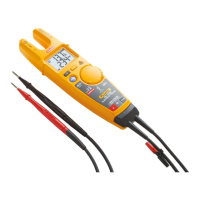Performance Verification
4.6 Scope Input A, B, C, D Tests 4
4-15
1. Connect the Test Tool to the 5500A as for the previous test (see Figure 4-4).
2. Select the following Test Tool setup:
• Recall the created setup (e.g. SETUP 1, see section 4.4.3): press
SAVE
,
F2
RECALL , select SCREEN+SETUP 1 , press
ENTER
to recall the setup .
• Press
SCOPE
• Press
F1
– READINGS ON.
• Press
F2
– READING ... and select with
F1
– READINGS and with
the arrow keys:
Reading 1, on A, Peak ... and next Peal-Peak,
Reading 2, on B, Peak ... and next Peal-Peak,
Reading 3, on C, Peak ... and next Peal-Peak,
Reading 4, on D, Peak ... and next Peal-Peak.
• Press
CLEAR
to clear the softkey menu, and to see the full screen.
3. Using
TIMEsns
change the time base to select manual time base ranging, and lock
the time base on 1 ms/div.
4. Press
: using
MOVE
and
MOVE
move the Input A ground level (indicated by the
zero icon
in the left margin) to the center grid line.
5. Using
mV
RANGE
and
RANGE
select manual vertical ranging, and set the Input A sensitivity
range to 100 mV.
6. Set the 5500A to source the appropriate ac voltage and frequency, according to
Table 4-5.
7. Observe reading
A and check to see if it is within the range shown under the
appropriate column.
8. Continue through the test points.
9. Now check channel B, C or D in succession:
Press
TRIGGER
and select B, C or D as trigger source with
F1
,
Press B, C or D to assign vertical ‘range’ and ‘move’ to channel B, C or D,
Observe reading B, C or D.
10. When you are finished, set the 5500A to 0 (zero) Volt, and to Standby.
Table 4-5. Volts Peak Measurement Verification Points
5500A output, Vrms (sine) 5500A Frequency Reading A, B, C, D
212.13 mV (0.6 V pp) 1 kHz 0.56 to 0.64
4.6.6 Input A, B, C, D Frequency Measurement Accuracy Test
Proceed as follows to test the frequency measurement accuracy:
1. Connect the Test Tool to the 5500A as shown in Figure 4-5. Do NOT use 50 Ω
terminations!

